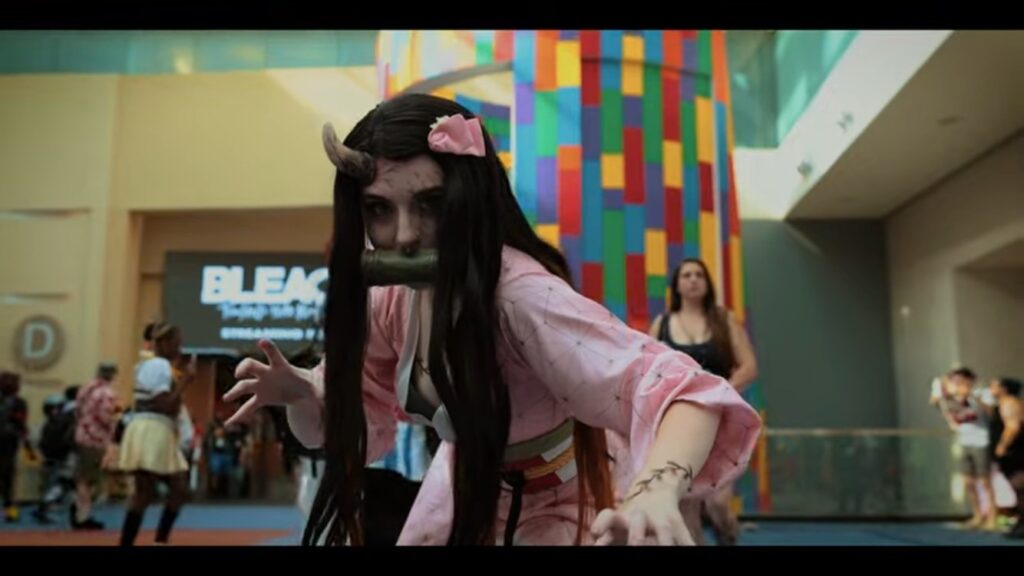Primed for Otakon
By • August 1, 2024 0 1279

Are you an otaku, a person obsessed with Japanese comics, animation and video games?
If so, you are no doubt preparing to storm the Walter E. Washington Convention Center this weekend, Aug. 2 to 4, with 40,000 other DMV otaku. It’s time for Otakon.
Launched 30 years ago in State College, Pennsylvania, by 350 fans of Japanese pop culture, Otakon is one of the top 10 events of its kind in the U.S. Number one (ichiban), with over 100,000 attendees: L.A.’s Anime Expo in early July.
After a few years in Maryland’s Hunt Valley and Virginia’s Crystal City, then 18 in Baltimore, Otakon busted out of the Baltimore Convention Center, relocating to the District in 2017.
As a primer for first-timers and baffled D.C. residents, a glossary of basic terms follows.
It all begins with manga, Japanese comics and graphic novels. In D.C., you can find them at Fantom Comics in Dupont and Big Planet Comics on U Street. The best-seller in this country is “Kimetsu no Yaiba,” written and drawn by Koyoharu Gotouge. Running in a weekly magazine in Japan from 2016 to 2020, “Demon Slayer” came out in English starting in 2019; it’s now available in a box set.
The story takes place in early 20th-century Japan. Our sword-wielding hero is Tanjiro, most of whose family was slaughtered by demons. The good news: his younger sister Nezuko survived. The bad news: she’s now a demon. Though she still prefers pink, she has horns and fangs (her mouth is sealed with a piece of bamboo to keep her from biting anyone).
The “Demon Slayer” characters have since appeared in a TV series and three movies created by animation studio Ufotable — anime, in other words. In the U.S., the main streaming service for “dubbed and subbed” anime is Crunchyroll, owned by Sony.
Among the more than 75 featured guests participating in Otakon performances, panels and workshops are voice actors in anime and video games — especially the Final Fantasy franchise — including several heard in “Demon Slayer”: Erica Lindbeck (Daki), Brandon McInnis (Gyutaro), Max Mittelman (Sabito) and Koki Uchiyama (Rui).
Two related terms: AMV, an anime music video made by a fan by setting clips to a pop song (Otakon has an AMV contest); and anison(g), a theme song or another musical selection from an animated film or a video game, now its own genre. “Homura,” the opening theme from one of the “Demon Slayer” movies, was a worldwide 2020 hit for J-pop (see below) singer LiSA (that’s how she spells it). Anison band FLOW will perform at Otakon on Aug. 2.
Otaku are stereotypically loners, caught up in fantasy worlds behind their closed bedroom doors. When they do socialize, they love to dress up as their favorite manga, anime and video game characters. This is called cosplay, short for “costume play.” LARP, live-action role-playing, in which you interact with others in character, takes cosplay to the next level of theatricality (or lunacy).
Noted with pride: “The Otakon LARP has been running since the second Otakon in 1995. In that decade and a half, we’ve grown to host 250 players, the largest anime LARP in the world.”
Attendees show up in a range of outfits, masks and makeup, with signature props. Kaiju refers to Godzilla-like monsters and mecha (pronounced “meck-uh”) to Transformer-like robots. The soft, often furry, full-body suits are called kirugumi, which translates as “wearing stuffed toy.” Two now-classic Japanese streetwear styles for women are “maid” — short black dress, white apron and knee socks — and Lolita, essentially Victorian goth or steampunk.
In addition to its Maid Cafe and Lolita Garden and Fashion Show, Otakon will host a Lolita Tea Party on Aug. 3 at the Marriott Marquis. Allowed at Lyra’s Formal Ball on Aug. 2: Lolita, kimono, cheongsam, tuxedos, gowns, prom and cocktail dresses, dress uniforms, kilts and “Formal Medieval/Renaissance/Period Attire.”
As should be clear, conventions like Otakon are giant costume parties, with numerous opportunities for posing (backdrops provided), dancing and mock fighting. Otakon’s costume contest has five categories and many rules. Glitter, confetti, pyrotechnics, live flame and smoke generators are forbidden. Also: “Altering of skin pigmentation to match a real-world culture to which the contestant does not belong is not permitted and will result in immediate disqualification.”
Saturday is the big night. There is a masquerade with prizes, the Neon Crabby Dance from 9 p.m. to 1:30 a.m. (no fighting, no glow sticks on strings, no excessive public displays of affection) and Sonicboombox’s Otakon 30th Anniversary Afterparty from 8 p.m. to 2 a.m. at Spin DC, 1332 F St. NW.
Though Otakon’s main inspiration is Japanese mass culture, there is an admixture of content from the Marvel and DC universes. Meanwhile, the Korean Wave is going strong. J-pop, Japanese pop music, is a thing, but it has been swamped by K-pop, though the precision septet BTS (Bangtan Sonyeondan or “Bulletproof Boy Scouts”) is currently on hiatus for the boys to complete their military service. Otakon will feature a number of K-pop performers.
Gamers can easily avoid in-person human interaction. More than 150 games, from Alien VS Predator to Zaxxon, are on Otakon’s arcade list. And there is plenty to browse and buy: manga, anime, art, crafts and merchandise.
For those looking to sample the scene, in partnership with the Embassy of Japan and others, Otakon is presenting a free Matsuri Street Festival — matsuri being the Japanese word for festival — on Aug. 1 from 4 to 8 p.m. on the grounds of the Apple Carnegie Library, 802 K St. NW.

